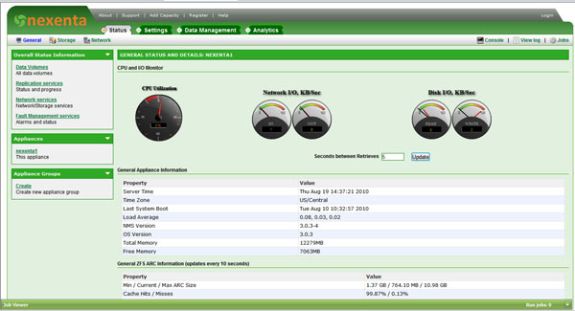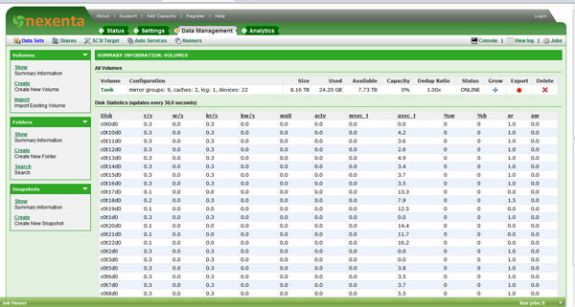ZFS - Building, Testing, and Benchmarking
by Matt Breitbach on October 5, 2010 4:33 PM EST- Posted in
- IT Computing
- Linux
- NAS
- Nexenta
- ZFS
Nexenta
Nexenta is to OpenSolaris what OpenFiler is to Linux or FreeNAS is to FreeBSD. It is a purpose built version of OpenSolaris designed primarily around storage networking including NFS, CIFS, and iSCSI/FC block based storage. Nexenta has taken a lot of time building a great front-end to manage ZFS enabled storage and integrate a plug-in manager that can extend the abilities of a standard x86 platform to rival the best
Nexenta comes in three flavors, Nexenta Core, Nexenta Community, and Nexenta Enterprise. The availability of these three versions allows you to select what kind of product you want, and what kind of expenditures that you will incur.
Nexenta Core is the most basic of the options, but it is also the most forgiving in terms of licensing. Nexenta Core is a command line interface platform only. It is based on an OpenSolaris kernel, and an Ubuntu Userland. There is no limit to the amount of storage that you can configure or use with Nexenta Core, and it is completely free. Nexenta Core can be found here.
Nexenta Community is the next step up. Nexenta Community is based on Nexenta Core, and includes a great GUI interface for managing all aspects of the storage platform. Nexenta Community is also free, but it is limited to 12TB of used storage. Nexenta Community Edition can be found here.
Nexenta Enterprise is the top-level offering. Nexenta Enterprise is a superset of Nexenta Community with many Enterprise level features, including support options. Nexenta Enterprise is licensed based on RAW storage capacity. You can find pricing information here.
Screenshots of web GUI
Nexenta has been very easy to use in our testing. After a few minutes of familiarization with the interface everything is pretty straight forward. You can go from a bare installation to something that has an array configured, an iSCSI target configured, and is ready to take data in a matter of 5-10 minutes. All of the features for sending out notifications and for lighting up indicator lights work as expected and are easy to configure. With just a few menu clicks you're ready to enter all of the information that the system needs to notify you about any problems that it encounters.
Some of the shortcomings that we saw in the Nexenta Enterprise offering were in the reporting and support areas of the product. We did not investigate the reporting problem in depth, as it was not pertinent to the performance data of the system. We would expect that with a little troubleshooting it would be something that would be easily resolved. Throughout the testing process though the daily reports stated that there was no network traffic being generated even though we were loading the interface quite heavily during testing.
This brings us to our next issue that we had with Nexenta, and that was the support channels. We would have gladly troubleshot the issues with reporting if we thought it was going to be done in a timely manner. Since we were using the Enterprise Trial license the support was lackluster at best. We were assured by sales representatives that paid-for support is much faster and much better than the "free trial" support. Free Trial support is treated as their lowest priority support queue. We were not impressed with this as we have always thought of a time-limited free trial period to be pre-sales. If you want to convert someone from a non-paying free trial to a paid product, show them how good the product and support is during that period.












102 Comments
View All Comments
mbreitba - Tuesday, October 5, 2010 - link
Thanks for the comment on the ZIL.As far as using the X25-E's as ZIL devices - when we built the box initially, the X25-E's were the best choice at the time. Future builds will probably include a capacitor-backed SSD.
James5mith - Tuesday, October 5, 2010 - link
For what it's worth, we are currently using roughly 16 of the Supermicro 846-E1 chassis in our storage solutions.Drive numbering is from bottom to top, left to right. Don't know if this helps or not.
5 11 17 23
4 10 16 22
3 9 15 21
2 8 14 20
1 7 13 19
0 6 12 18
badhack - Tuesday, October 5, 2010 - link
I would be curious to know how the performance compares to traditional fs caching on Linux w/ ext3 or ext4 with same amount of memory and a few SSD drives.Maveric007 - Tuesday, October 5, 2010 - link
There are a few options within Linux that would be pretty interesting to see. FS caching and the different schedulers that are available within Linux. Also I would throw out ext3 and replace that with ext4 and xfs. Redhat is now supporting xfs and there are just tons of tunables for xfs compared to the other file systems.badnews - Tuesday, October 5, 2010 - link
Thanks Matt, I've been following the build over at your blog and this is an excellent article to tie it all together. I hope you follow up with your "things we'd do differently" in future articles. I would also love to see some more benchmarking against more alternatives, e.g. Open-E, or even an off-the-shelf EqualLogic.Keep up the good work :)
Fallen Kell - Tuesday, October 5, 2010 - link
Well, I know at least for Solaris 10.... I would suspect that OpenSolaris has it as well by now, since it has been out for at least 4 years that I know of...https://<host>:6789
mbreitba - Tuesday, October 5, 2010 - link
You can install the ZFS Web GUI from the Solaris toolkit, but it isn't bundled into OpenSolaris. It is binary compatible, but it doesn't give any good options for iSCSI setup, as it only supported the old iSCSI target rather than the new COMSTAR target.sfc - Tuesday, October 5, 2010 - link
How can you spend a page talking about how you aren't really worried about the future of Opensolaris, and then have half a paragraph mentioning "oh, btw, it's cancelled"? The project is clearly dead. They stopped releasing source almost a month ago. Oracle has made absolutely no guarantees about when or how source would be released in the future. For all we know, they could release only portions of Solaris Express, and do it months to years after the binaries drop.http://opensolaris.org/jive/thread.jspa?messageID=...
I love ZFS/Opensolaris, I use it at home, but Opensolaris is dead.
Mattbreitbach - Tuesday, October 5, 2010 - link
OpenSolaris is indeed dead as far as development goes, but it's still viable if you want to use the last build released which is what all of our performance figures are based on. I will be writing some companion articles to this one talking about not only the death of OpenSolaris, but it's alternative, OpenIndiana, and the Promise M610i used as a comparison in this article.andersenep - Tuesday, October 5, 2010 - link
The OpenSolaris project may be dead but ZFS and all the CDDL licensed code is still out there. Illumos, OpenIndiana and a few other distros are still out there and available. Oracle has stated they will continue to release source code after Solaris releases and will also provide binary preview releases in the form of Solaris Express. To say Solaris and ZFS are dead is pretty premature.Whatever happens, the existing code is out there. To call it dead is a bit premature. Sure the project that had the name 'OpenSolaris' has been canceled, but everything that made it up (minus a small few closed bits that have already been replaced) lives on.